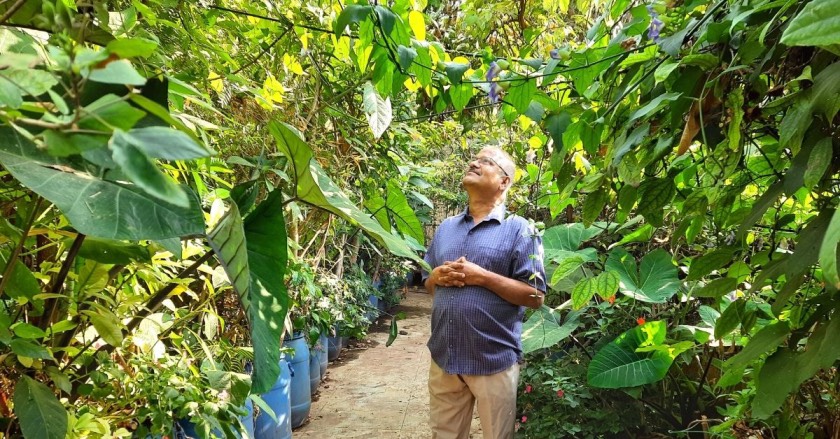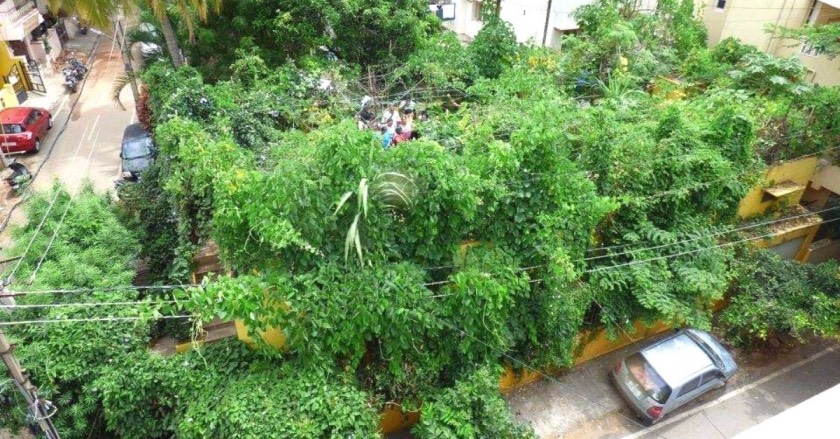In the early summer of 2010, Nataraja Upadhya was feeling the need to set up a water cooler to deal with the impending heat. As he geared up for temperatures to soar in Bengaluru, where he lives, he thought of how he could help regulate the temperature in his own home. He was already maintaining a garden in front of his house, located in Vivekanandanagar in Banashankari area, so he decided to begin gardening on his terrace as well, to have a relatively cool roof.
“Bengaluru is known as a garden city, but today, the scenery has been replaced by a concrete jungle. Rampant tree cutting due to growing urbanisation and climate change have all resulted in rising temperatures,” Nataraja tells The Better India.
Up until 2008, the 58-year-old IT professional had been leading a hectic lifestyle. Once he retired, his aim became to concentrate on his health. “I was working 18 hours and driving around five hours a day. My specially-abled wife and two daughters needed me. Hence, I quit to focus on my health and family,” he says.
Nataraja belongs to a farming family, hailing from Parampalli in Udupi. So he decided to go back to his roots, and pursue his love for gardening and nature. “I’d spent years of my childhood growing plants with my father. Even before I began pursuing engineering, I used to maintain the plants on our balcony,” he recalls.
Creating a self-sustaining ecosystem

Banking on this previous experience, Nataraja began growing plants in rice bags and discarded containers. “I started by growing a few vegetables and medicinal plants. My home has a terrace of around 1,500 sq-ft, which opened the potential to grow bigger plants and trees. So by 2012, I started growing trees in recycled 55-litre drums,” he says.
Over the past years, Nataraja’s consistent efforts have seen the growth of 300 varieties of plants, including 100 trees of 72 species, creepers, fruit trees, and vegetables. The terrace has a dense green cover, with trees including moringa, bamboo, drumstick, tamarind, and wild fig. The view is a sight for sore eyes, as the garden hosts 50 varieties of butterflies, about a dozen species of birds, hundreds of insects, squirrels, and bats, among others. The best part here is that Nataraja does not need any cooler or fan during the summer, but definitely a thicker blanket in winters, he admits.
“I call it an urban evergreen forest, as the greenery never fades. The creepers from the ground are connected to the roof and create a natural curtain. There are some plantations on 400 sq-ft of the garden, as well as along the protection wall of the house. The overall greenery helps keep temperatures at bay by 2-3 degree Celsius,” he adds.
The plantation is, in no way, haphazard. In fact, a lot of thought and planning has gone into creating the green zone.

Nataraja says the house is old, having been constructed in 1987. Hence, to reduce the stress on the roof, he placed the drums along the periphery of pillars. “The burden is put on the pillars to keep the slab safe. I also took care of leakages and other waterproofing of the terrace,” he adds.
“The micro jungle is a demonstration of how an urban green cover can be created by maximising per sq-ft area, which houses plants, birds, insects and other elements that support biodiversity. In the age where species face threats of extinction, such private and public urban spaces could serve as a place for refuge,” Nataraja says.
He adds that all plants in his house are grown in compost, and using organic methods. “Using compost helps reduce the weight of the drums. Since there is no demand for productivity in terms of harvesting vegetables from the forest, the focus is not on improving soil quality. Hence, there is no stress on the outcome, and the compost alone suffices,” he explains.
He adds that he never needs insecticides or pesticides for protecting the plants. “The jungle has created an ecosystem in the process. The insects in the food chain ensure that no infestation occurs, and keep the plants healthy,” he says, adding, “Rainwater automatically percolates in the ground, and installing a rainwater harvesting system is not required to recharge groundwater.
How nature supports itself

Nataraja says the trees grown in the drums do not grow over 15 feet. “The area around the tree hosts several bushes and plants, which all complement each other’s growth. Nature has supported itself. Such propagation has about 1,700 plants growing in these drums,” he adds.
He also says that since 2010, he has not thrown any kitchen waste out of his house. “All waste is converted into compost,” he adds. He says his efforts are benefitting the neighbourhood. “There is more oxygen generated in the space, and people around get fresh air. The benefits are for the community at large, and not limited to a personal level,” he says.
Nataraja has documented the progress of his initiative on YouTube. His channel has over 450 videos that address different aspects of biodiversity through his experiences in creating the urban jungle. He also runs a Facebook page to interact with nature lovers and guide them through his knowledge.
He expresses his views on conserving nature through his blog, Billion Trees and Beyond, to create awareness among people. “I appealed to readers to pledge and plant trees in their lifetime. Many have agreed to support the cause. I have also distributed over 2,000 Mexican sunflower seeds among the neighbourhood to encourage the urban population to grow trees,” he adds.
Nataraja says that through the exercise, he wants to send multiple messages to people. “I want to show that creating a green space in a small area of land is possible. There is no threat to the structure, or any other constraints. It is not rocket science, and anyone can do it,” he adds.
“Most importantly, converting our urban spaces into green zones has become imperative with the increasing threat of climate change. Such initiatives will help the society at large,” he says.
Edited by Divya Sethu
No comments:
Post a Comment